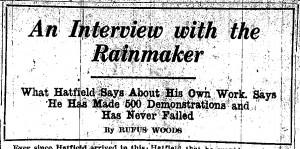From the desk of Steve Willis, Central Library Services Program Manager of the Washington State Library:
The reel grabbed at random this week contained The Big Bend Empire, the first newspaper established in Waterville, Washington. The issue for May 13, 1920 included this intriguing article:EPHRATA TO TRY OUT RAINMAKER
"The people around the Grant county seat want rain, and in fact they are willing to try any old scheme to get it, even to employing a professional rainmaker."
"The Ephrata Commercial Club has entered into negotiations with Chas. M. Hatfield of Los Angeles, who claims to have had success in rainmaking in other sections." "The fact that the commercial club of Ephrata became interested in Mr. Hatfield's proposition made it possible to guarantee $6,000 to Mr. Hatfield. Under the contract with the Commercial club he is to receive for first inch nothing; for second inch $3,000; third, $3,000 additional with a time limit of June 10. We understand that Mr. Hatfield is now on the ground and busy with his experiments." Charles Mallory Hatfield was already a famous figure throughout the West by 1920. The dapper 45 year-old sewing machine salesman had a strong resume, he claimed, of creating conditions which would result in rain for the parched corners of the world. His method included mixing a concoction of 23 chemicals (to this day the ingredients remain a secret) and setting this stew in vats atop 20-ft. high towers near bodies of water. Hatfield's place in the history of "pluviculture" earned him an entire chapter in Clark C. Spence's The Rainmakers (1980). One editor is quoted in this work on the odoriferous impact of Hatfield's towers, writing they smelled like "a limberger cheese factory has broken loose ... These gases smell so bad that it rains in self defense." Electricity was also used in the process.





